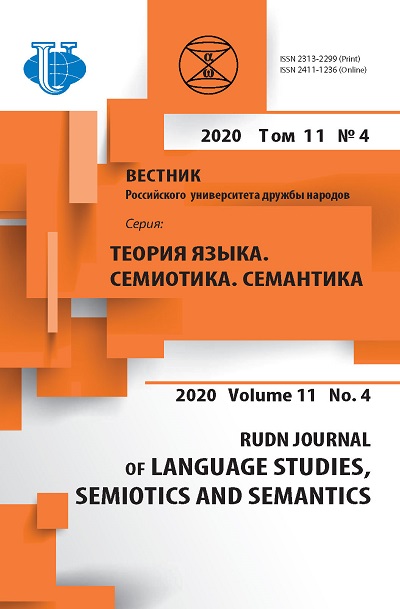Functional and Semantic Attribution of the Future Tense Grammatical Markers in The Korean Language
- Authors: Mamontov A.S.1, Stolyarova A.G.1
-
Affiliations:
- Pushkin State Russian Language Institute
- Issue: Vol 11, No 4 (2020)
- Pages: 611-624
- Section: Functional grammar. Functional Semantics
- URL: https://journals.rudn.ru/semiotics-semantics/article/view/25043
- DOI: https://doi.org/10.22363/2313-2299-2020-11-4-611-624
- ID: 25043
Cite item
Full Text
Abstract
The article discusses functional and semantic status of Future Tense grammatical markers of the Korean language. Despite the fact that discussions on this issue have been going on for more than a dozen years, still among researchers, there is no consensus on how many grammemes make up the category of Tense in Korean, whether it contains an independent Future Tense grammeme, and if so, which markers should be relevant to it. Due to the relevance of the problem, the authors aim to give a brief overview of the opinions on the issue, dividing them into two groups - asserting the presence of the Future Tense grammeme in Korean or denying it, as well as to justify personal position on the status of grammatical markers with prospective semantics. As research material, various Korean grammar researches and Korean grammar (connective and finite endings and constructions with - (으)ㄹ Korean Future Tense participle marker) are used. The result of the study shows that Korean Tense category has no specific Future Tense forms as opposed to the Present and Past Tense forms. All markers with prospective semantics are modal, which means that the Futurum category in Korean implements itself in the functional and semantic field of modality rather than temporality. Authors argue statement that -(으)ㄹ 것이다 Korean construction has the ability to act as neutral non-modal Future Tense marker. According to the point of view of a systemically oriented approach to the grammatical units analysis, presented in the article, the conclusion about Korean -(으)ㄹ 것이다s’ modal status is made.
About the authors
Alexander S. Mamontov
Pushkin State Russian Language Institute
Author for correspondence.
Email: as-mamontov2@yandex.ru
PhD (Advanced Doctorate), Professor, Department of Language Arts and Intercultural Communication
6, Akademika Volgina st., Moscow, Russian Federation, 117485Alexandra G. Stolyarova
Pushkin State Russian Language Institute
Email: aleks-stolyarova@yandex.ru
PhD student, Department of Language Arts and Intercultural Communication
6, Akademika Volgina st., Moscow, Russian Federation, 117485References
- Plungjan, V.A. (2011). Introduction to the Grammatical Semantics: Grammatical Meanings and Grammatical Systems of World Languages. Moscow: Russian State University for the Humanities. (In Russ.).
- Lee, Chuhong. (2015). Aspectual and Modal Characteristics of Future Actions in Russian through the prism of Korean language. Vestnik CMO MGU (Vestnik centra mezhdunarodnogo obrazovanija MGU. Filologija. Kul’turologija. Pedagogika. Metodika), 3, 22—27. (In Russ.).
- Russian Grammar. Vol. 1—2. (1980). N.Yu. Shvedova (Ed.). Moscow: Nauka. (In Russ.).
- Lee, Chungmin. (1987). Temporal expressions in Korean In The Pragmat. Perspective: Selected Papers from 1987 Int’l Conference on Pragmatics. John Benjamins. Verschueren & Bertuccelli-Papi (eds). pp. 435—453.
- Sonh, Sung-Ock. S. (1995). Tense and aspect in Korean. Honolulu: Center for Korean Studies, University of Hawai’i, 1995.
- Ramstedt, G.J. (1951). A Korean Grammar. Moscow: Izdatelstvo inostrannoj literatury. (In Russ.).
- Martin, S.O. (1992). A Reference Grammar of Korean: a Complete Guide to the Grammar and History of the Korean Language. Tokyo: Tuttle.
- Lee, H.B. (1989). Korean Grammar. N.Y.: Oxford University Press.
- Mazur, Yu.N. (1997). Korean Language. In Yazyki mira: Mongol’skie yazyki. Tunguso-man’chzhurskie yazyki. Yaponskii yazyk. Koreiskii yazyk. Moscow: Indrik publ. pp. 361—398. (In Russ.).
- Mazur, Yu.N. (2001). Korean Grammar (Morphology. Word Formation). Theoretical course. Moscow: MSU International Center for Korean Studies — “Muravej-Gaid” publ. (In Russ.).
- Paek, Pong Cha. (2015). Grammatical Dictionary of Korean as Foreign Language. Seoul: Hau publ. (In Korean).
- Lee, Keedong. (1993). A Korean Grammar on Semantic-Pragmatic Principles. Seoul: Hankuk Moonhwasa publ. (In Korean).
- Seo, Cheong Soo. (1996). Korean Grammar. Seoul: Hanyang University publ. (In Korean).
- Trofimenko, O.A. (2006). Extraction of the Mood Markers in Korean. Izvestia: Herzen University Journal of Humanities & Sciences, 2(3), 71—74. (In Russ.).
- Yoo, Mok Sang. (2007). Korean Grammatical Structure. Seoul: Hankuk Moonhwasa publ. (In Korean).
- Trofimenko, O.A. (2016). Formation and Development of the Mood Markers in Korean. In Novosibirsk State University Bulletin. Series: History and Philology, 10(15), 90—98. (In Russ.).
- Vasil’ev, A.G. (1999). Potential Mood in Korean. Vestnik Tsentra koreiskogo yazyka i kul’tury, 3—4, 7—15. (In Russ.).
- Rudnickaja, E.L. (2010). Disputable Issues in Korean Grammar: Theoretical Issues and Ways of Their Solving. Moscow: Vostochnaja literatura (In Russ.).
- Kondrat’eva, E.N. (2005). Grammar of Predicative in Early-New Korean: from Middle Korean to New Korean. PhD dissertation research. Moscow. (In Russ.).
- Munkueva, N.S. (2010). Temporal and Aspectual Meanings of Korean Participial Forms. Vestnik Buryatskogo gosudarstvennogo universiteta, 8, 101—104. (In Russ.).
Supplementary files












